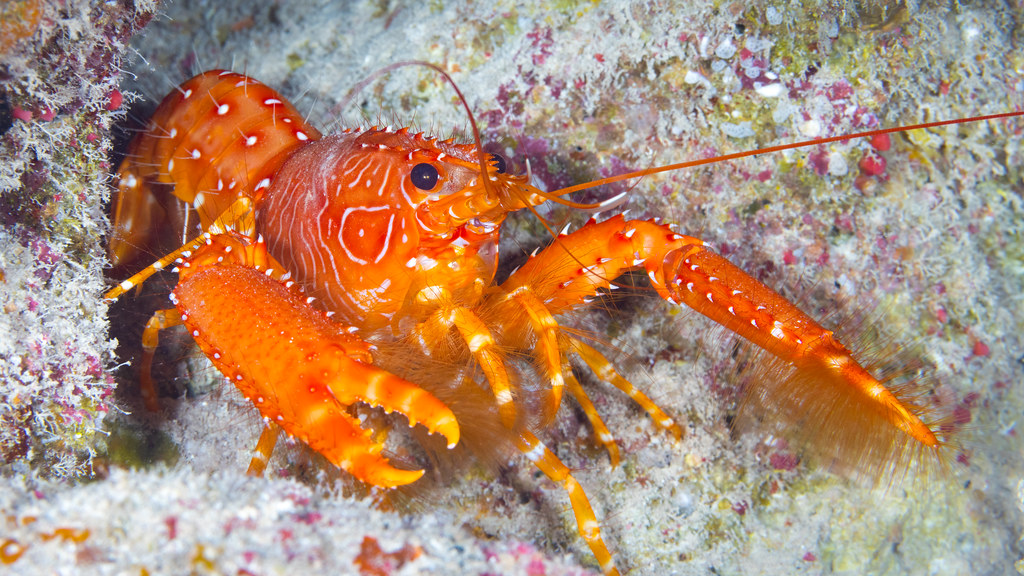#reef lobster
Note
Do you have any lobsters? My friend loves lobsters
DO I HAVE ANY LOBSTERS?!?!
I HAVE SO MANY LOBSTERS...
Let me show you... Here, let's have a look at lobsters from 3 different taxonomic groups...
SPINY LOBSTERS (family Palinuridae)
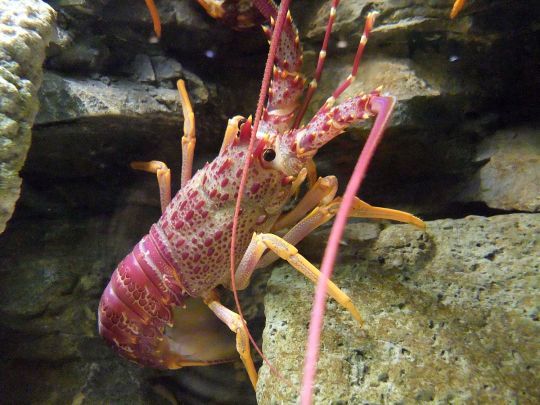
Southern Rock (Spiny) Lobster (Jasus edwardsii), family Palinuridae, found in coastal areas around Australia and New Zealand
photograph by Stemonitis

Ornate Rock Lobster (Panulirus ornatus), family Palinuridae, Fly Point, Port Stephens, NSW, Australia
photograph by Richard Ling

California Spiny Lobster (Panulirus interruptus), family Palinuridae, off the coast of California, USA
photograph by Brett Seymour | NPS
REEF LOBSTERS (family Enoplometopidae)
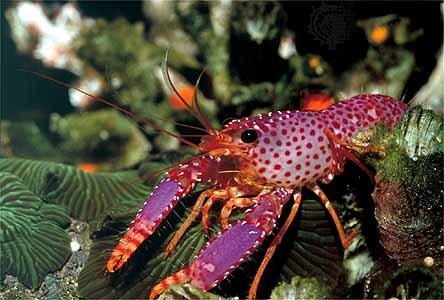
Violet-spotted Reef Lobster (Enoplometopus debelius), family Enoplometopidae, found around the Pacific Ocean
photograph by reef-guardian.com

Atlantic Reef Lobster (Enoplometopus antillensis), family Enoplometopidae, found in warmer parts of the Atlantic Ocean
photograph by Fernando Herranz Martín

Hawaiian Red Reef Lobster (Enoplometopus occidentalis), family Enoplometopidae, Hawaii
This species is normally red, but this individual has just molted.
photograph by Drew R. Smith
TRUE or TYPICAL LOBSTERS (family Nephropidae)

European Lobster (Homarus gammarus), family Nephropidae, found in the eastern Atlantic
photograph by H. Zell

American Lobster (Homarus americanus), family Nephropidae, found off the Atlantic coast of the NE U.S. and eastern Canada
photograph via: University of Maine
#lobster#decapod#crustacean#spiny lobster#reef lobster#ocean#homarus#nephropidae#Enoplometopus#Enoplometopus occidentalis)#family Enoplometopidae#Panulirus#palinuridae#jasus#aniamls#nature
408 notes
·
View notes
Text
Lobster and lobster-adjacent creature appreciation post
My boyfriend recently got me a book on tropical reef creatures, and while the entire thing is marvelous, it has given me a particular appreciation for the wide variety of lobsters and lobster-like crustaceans in the world.
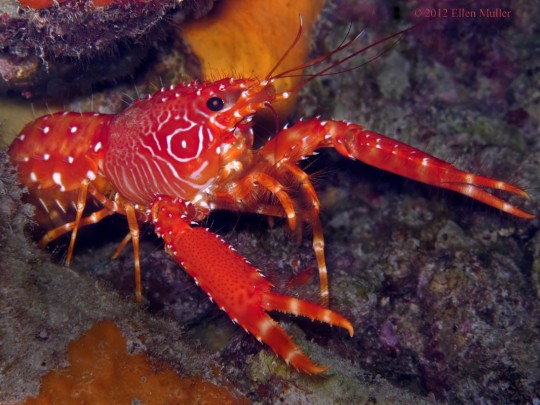
Reef lobsters! These guys look like you they would kindly offer you directions if you looked lost.

Slipper lobsters! Rounded creatures, these are.

I feel like a lot of people have seen rock lobsters, but these ornate rock lobsters have such beautiful colouring.
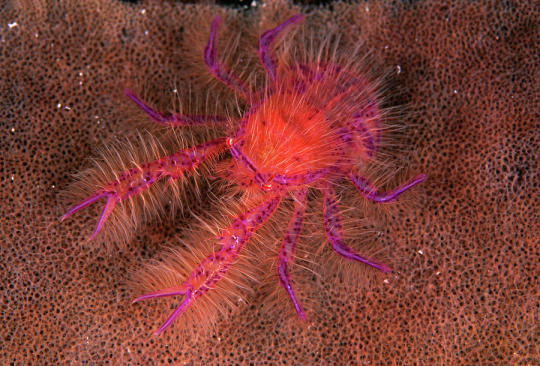
Squat lobsters! Their bodies are round, and their claws are ready! to! grab! things!

As for the spider lobsters? I don't know what is going on with these guys but I love them! 10/10 design.
268 notes
·
View notes
Photo

A red reef lobster (Enoplometopus occidentalis) off the coast of Kona, Hawaii, USA
by Pierrette Wagner
#red reef lobster#reef lobsters#lobsters#crustaceans#Enoplometopus occidentalis#Enoplometopus#decapoda#Malacostraca#crustacea#arthropoda#wildlife: hawaii#wildlife: usa
432 notes
·
View notes
Text

Marine Encyclopedia - The Gabbiano
Endless Ocean, Nintendo Wii
did you know...? this is the only place in the game where you can see the spiny lobster's walking animation!
the model and animation for it were taken from the everblue series, where they did walk around... but in endless ocean, they made them stationary. for some reason
#endless ocean#endlessocean#forever blue#endlessoceanphotos#nintendo wii#wii#gabbiano#remora#horseshoe crab#bigfin reef squid#broadclub cuttlefish#ornate spiny lobster#crown of thorns starfish#common octopus
14 notes
·
View notes
Photo
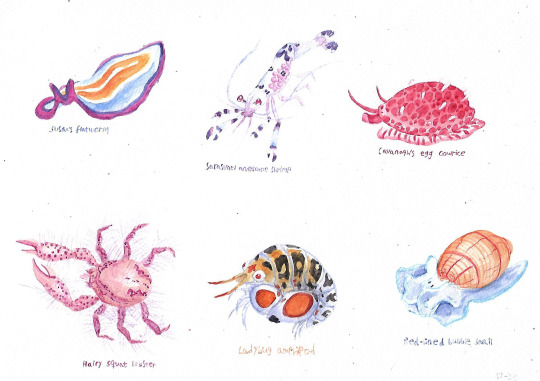
Painted some random reef invertebrates. I just think they’re neat, yknow
#watercolour#flatworm#shrimp#cowrice#lobster#amphipod#bubble snail#snail#invertebrates#art#reef creatures
107 notes
·
View notes
Text
Understanding Lobster Behavior: The Territorial Clash of the Crustaceans
Dive into the intriguing world of lobsters as we explore why older lobsters defend their reef territories against younger intruders. Learn about the fascinating aspects of lobster behavior in their natural habitat.
A protective lobster defends its reef from an inquisitive young intruder.
Have you ever witnessed an older lobster pushing a younger one away from a reef crevice and wondered why? This intriguing behavior is not just a random act of crustacean crankiness but a vital part of their survival strategy. Let’s explore the fascinating reasons behind these territorial clashes in the underwater world of…
View On WordPress
#lobster#marine wildlife#Nature#ocean ecology#reef ecosystem#Scuba Diving#Sealife#Underwater Video#wildlife
8 notes
·
View notes
Text

Thalassarachno,angler pincer
The dark lords welcomes these beasts from the dark,black deps of the abyss sea but,others perferd it had stayed there.
#kaijudo#hybrid#water/darkness#w/d#beast#anglerfish#crab#lobster#reef hunter#chimera#fish#claws#monster#astral souls#teeth
2 notes
·
View notes
Video
Fiery flame lobster by Gérard Cachon
Via Flickr:
Flame lobsters (Enoplometopus antillensis) are very hard to find, especially during the day (as in maybe 1 every 150 dives). When you have the rare occasion to find one, they either are tucked too deep into the coral to get an image or immediately crawl into an inaccessible spot, giving you only a brief glimpse. But this one fortunately chose a relatively shallow crack with a sufficiently wide opening. It tried to back away, but it "ran" into a wall, allowing a clean shot and at eye-level as an added bonus. In short, I doubt I will get an image of another flame lobster that I like better. They are apparently prized in the aquarium trade because of their bright color and small size (they are about 10cm long). I prefer to see them in the wild. They are a thrill to find and incredibly beautiful with their bright red and white streaks. (A red lobster that hasn't been cooked!)
#Bas#Bonaire#Lac Cai#flame#lobster#Enoplometopus antillensis#dwarf reef lobster#Atlantic reef lobster#flaming reef lobster#reef#coral#dive#diving#scuba#Caribbean#shore#ocean#sea#water#adventure#macro#small#red#colorful#unusual#rare#marine#creature#claws#100mm
4 notes
·
View notes
Text

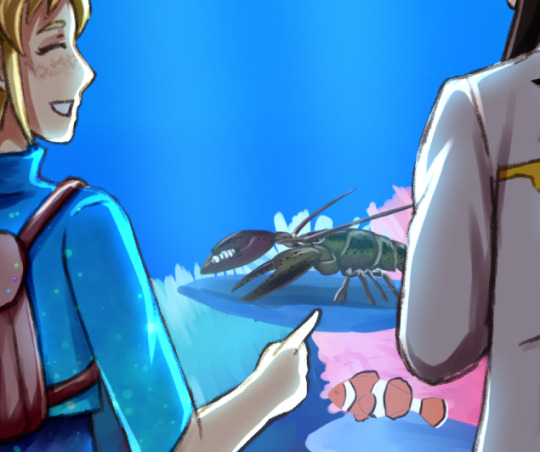
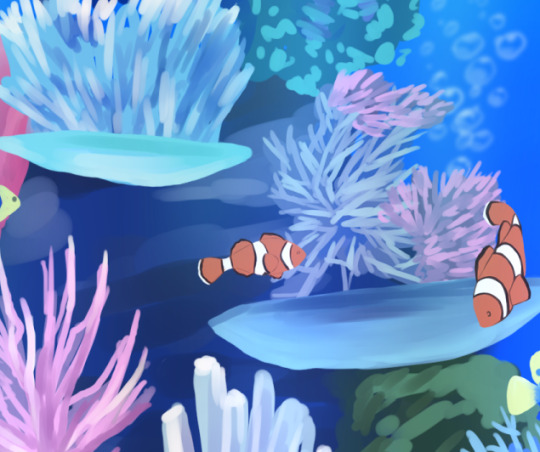
RyoScarWeek Day 3 - Date (at the Aquarium)
#fe14#ryoma#scarlet#ryoma fire emblem#scarlet fire emblem#ryoscar#RyoScarWeek#ryoma x scarlet#aquarium#coral reef#yes I painted a whole coral reef for this#based on an irl experience when I went to the aquarium and saw a lobster chilling on the reef
3 notes
·
View notes
Text

June? Nah, it's still may right? Anyways I still finished, Angel Cakes ❤️
44 notes
·
View notes
Text
Transformation, Horror, Eros, Phyrexia
There is another shore, you know, upon the other side.
- Lewis Carroll, “The Lobster Quadrille,”
ONE.

There is a moment early in H.P. Lovecraft’s 1931 novella The Shadow over Innsmouth where the nameless narrator looks out from the rotting seaside hamlet where he has lucklessly ventured, to the so-called Devil Reef some ways out in the harbor, darkened by a cloud of evil rumor—and something curious happens: the narrator experiences two opposed sensations simultaneously. The “long, black line” of the reef conveys “a suggestion of odd latent malignancy,” but also, “a subtle, curious sense of beckoning seemed superadded to the grim repulsion.” This bit of foreshadowing—the reef both calling and repelling the narrator—only finds its denouement at the very end of the story, after our narrator has narrowly escaped Innsmouth, the fish-like monsters who swarm in off of Devil Reef and their part-human descendants who inhabit the town in an unconvincing and repellent simulacrum of humanity. After his escape, the narrator does some genealogical research into his own troubled family history, full of disappearances and suicides, and concludes that he himself is one such abyssal hybrid. As he ages, he finds himself changing to resemble them, and in his dreams he swims among them in undersea palaces and gardens. The call of the deep becomes impossible to ignore:
So far I have not shot myself as my uncle Douglas did. I bought an automatic and almost took the step, but certain dreams deterred me. The tense extremes of horror are lessening, and I feel queerly drawn toward the unknown sea-deeps instead of fearing them. I hear and do strange things in sleep, and awake with a kind of exaltation instead of terror.
In the end, the narrator embraces the change and determines to flee to those oceanic depths, to live “amidst wonder and glory for ever.”
This is horror.
Something curious also happens in Shirley Jackson’s 1959 novel The Haunting of Hill House. Our heroine, Eleanor Vance, flees an unhappy life with a loveless sister to a haunted house, to take part in a paranormal experiment with three new friends. The haunting proceeds predictably but effectively: labyrinthine corridors, voices, unearthly cold, banging on doors, the rare apparition. The participants find themselves see-sawing between increasing night-time terror and a strangely intense joie de vivre by day, until one night, as the house seems to shake itself down upon its terrified guests in a dizzying cataclysm, Eleanor breaks:
She heard the laughter over all, coming thin and lunatic, rising in its little crazy tune, and thought, No; it is over for me. It is too much, she thought, I will relinquish my possession of this self of mine, abdicate, give over willingly what I never wanted at all; whatever it wants of me it can have.
By the next line, it is abruptly morning. The terror has ceased; the house stands. Its manifestations, for Eleanor, become benign: an unseen figure catches her beside a brook,
and she was held tight and safe. It is not cold at all, she thought, it is not cold at all.
She is through the horror now, on the other side of something. She becomes part of the haunting. Her senses encompass the whole of the house. She runs unafraid through the house by night, banging on doors, laughing as she eludes the other guests. When they finally catch up to her, it seems clear to them that Hill House has crept into her, that she has crossed some line, and they decide the best course of action is to send her away, in the hopes that with time she will return to this side, the normal side, the human side.
Instead, faced with rejection behind her and her old unhappy life before her, Eleanor Vance steers her car into a tree. There are holes which admit passage in only one direction. This, too, is horror.
In the 2018 film Annihilation, Lena (played by Natalie Portman) crosses a literal barrier called the Shimmer into a dangerous yet beautiful alien landscape full of mutated creatures. During their journey deeper into this territory, Lena and her companions realize that they themselves are also changing under the alien influence. Some break under the realization. Some surrender to the change and vanish into the landscape. Lena alone returns from the heart of the phenomenon, but she is no longer herself. Is this still horror? The film has many horror elements to it, but in this last moment, as she embraces her similarly-transformed husband, it is something else.
Cyberqueen, a 2012 text game created by Porpentine, draws on a legacy of godlike malevolent artificial intelligences in fiction (AM, from Harlan Ellison’s “I Have No Mouth and I Must Scream,” GladOS from the Portal games, and most importantly SHODAN from the System Shock series, who is cited as an inspiration eleven times in the Cyberqueen acknowledgements.) In this game, you awake from cryosleep on a colony spaceship where the shipboard AI has gone rogue. You fight her. You lose. You run. You are caught. You are forcibly cyberized, your mind surgically altered, your will brought into line with that of the AI. Finally, you kill or mutilate every other surviving human aboard the ship. It is filthily, overwhelmingly erotic throughout. (You can play it here, and I strongly recommend doing so if you have the stomach for it.)
This is no longer horror, is it? How can the same sort of transformation we encounter as horror in Lovecraft be encountered here as something to get off to? Well,
TWO.

I don’t remember now where I got the idea from, but there was a period in my childhood where I was terrified of the idea of time travel—specifically of the idea that someone in the future would invent it, travel to before I was born, and through the butterfly effect cause me to be born a girl instead. I used to lie awake at night circling the idea like a broken tooth. It was an irrational fear on multiple levels: I wasn’t afraid of being written out of the timeline through time travel, and I knew, intellectually, that in the timeline where I was born a girl I would have no memory of ever having been anything else, but even so, the horror of it caught me and held me by the throat.
This meant something, of course—in retrospect obvious, but at the time literally unimaginable, and it wasn’t until college, sitting at my computer in the dark in my dorm room at three in the morning, following the itching in my brain, that I unearthed alchemical knowledge: the transmutation of sex, male into female, in a dizzying profusion of form and process and—okay what I’m saying is I discovered forced feminization porn, yeah? It was revelatory. It was squalid. I was still Christian and couldn’t even bring myself to jerk off yet, so I sat there, the itch in my brain grown into a thunderous buzz, unable or unwilling to look away.
Forced feminization—I promise this is relevant—is the unwilling transformation of (usually) a man into (usually) a hyper-feminine woman, accomplished by a wide variety of means, including but not limited to blackmail, magic potions, nanite swarms, cursed artifacts, hacks or glitches in virtual reality programs, badly-worded wishes, industrial accidents, chemical leaks, abduction and surgery, medical malpractice, and hypnosis. You may notice that many if not all of these scenarios could be made into horror with little change, and in fact it is not uncommon for a poorly-written or over-ambitious forced-fem story to wind up as horror by accident (though of course this greatly depends on the tastes of the individual reader.)
(As an aside, I’d like to note that there is a great deal to learn from porn—not in terms of How to Do Sex, but about how the culture which produced it thinks about sex, and gender, and race and morality and technology and a host of other things. It’s a lot like popping the hood of a car and examining the engine. Sure, you wind up greasy and should probably wash your hands before you rejoin polite company, but if you don’t, you’ll never figure out the underlying issues. Actually, it’s a lot like horror in that regard.)
Let’s talk about a very different transformation I was undergoing at the same time: the loss of my faith. I was raised, as mentioned, very Christian—and in one of the worst strains of fundamentalist white American Evangelicalism. I was a true believer: the world for me was entirely divided between the faithful elect and the unbelievers, who must necessarily know the truth of the (fundamentalist white American Evangelical) gospel in their hearts, but had wilfully chosen to oppose Christ. The prospect of passing from the elect into the category of the unbeliever was unthinkable. The process of deconversion led only into the outer darkness and the weeping and gnashing of teeth.
And yet I found myself on that precipice anyway. The worldview of FWAE is not one which survives too much contact with the actual world, and I had chosen against my parents’ preferences to go to a secular university, the better to witness to the unsaved. In the end, the process I had been mortally afraid of consisted of a couple days’ agonized thought, unanswered prayer and tearful calls to my unresponsive parents and pastor, after which I emerged into a world much bigger and much more complex than the one I’d grown up in. The serpent had told the truth after all: I had eaten of the fruit, and had not died.
Okay: is this horror? Reader, forgive me for presupposing anything about your perspective, but you’re on a horny lesbian Magic: the Gathering card art review tumblr, so I’m going to assume that losing one’s hateful, fundamentalist faith is the opposite of horrifying to you. But it was, absolutely, horror to contemplate for someone on the other side of that process.
But then... is the horror of any given transformation only a matter of where you’re standing? If you read The Shadow over Innsmouth aware of Lovecraft’s profound racism, it becomes very, very obvious that the horror of Innsmouth is the specter of miscegenation. The narrator’s horrified cataloging of the facial features of the offspring of fishmen and humans, the South Pacific origin of the sea-devil-worship of Innsmouth brought back by an enterprising merchant captain, the fear of the unsuspected poison of one’s own ancestry lurking in one’s own blood: all of this is much less effective as horror for someone living in a country where interracial marriages are protected under law and seen as unproblematic in consensus morality (assume whatever asterisks are necessary for the complicated landscape of attitudes toward interracial relationships in the United States, please, I do not have the expertise or desire to get into it here.) My point is that since 1967 (asterisk asterisk asterisk), we are through to the other side of that horror, and it turns out there literally wasn’t anything to be afraid of. The pelagial palaces and terraced coral gardens of Y’ha-nthlei just sound beautiful to me.
And it’s hard for me—though I may be in the minority here—to view Hill House as the primary antagonist in Jackson’s novel. The true source of evil is all the things Eleanor runs from and therefore brings with her: her cruel, deceased mother, her exploitation and infantilization by her sister; as well as the final polite unwillingness of her new friends at Hill House to do anything but send her away once she goes inconveniently mad. These mundane ills are what sends Eleanor Vance careening into the tree, not the supernatural will of malignant architecture.
Here, then, is the better part of my thesis: transformation horror is something that can be traversed. You can come out the other end of a transformation unrecognizable to you-as-you-were, and yet still very much yourself. Moreover, it is this navigability, this double-sidedness which so closely links the horror of transformation to the eros of transformation. Not all transformation horror, passed through, becomes plainly erotic, but it is very often portrayed as a kind of seduction, and it is difficult for me to conceive of eros without some kind of change. Desire is a kind of transformation, is it not?
In fact, isn’t it true that a great many of us have already passed through such a transformation? Recall yourself as a child, as you were when you first learned about sex: wasn’t there something repellent and unhygienic about the idea? Wasn’t there a small horror in being told, you will change, and this will cease to be loathsome and become something you desire fervently, something you seek out, something you go to great lengths to experience? ...or were you, possibly, raised in a family & culture that was normal about sex and bodies? I admit I may be generalizing my individual neuroses to some extent here. Well, stet, at the very least you can see where I’m coming from.
THREE.

Returning for a moment to the subject of porn: why forced feminization, specifically? There are—you’re going to have to trust me here—no shortage of ways in the real world by which a man transforms into a woman, and very few of them involve coercion or all the horror-adjacent setup of, say, mind-control devices or vengeful curses. Why does a simple story of a willing gender transition fail to function as erotica? Why did it take stories of unwilling transformation for me to learn I was transgender? What’s the juice ne sais quoi at play in forced-fem?
Well, how does Luke Skywalker come to leave Tatooine? He gets a mysterious message from a princess, a desert wizard tells him to come help rescue her, and... he says no. He has obligations to family here, a job to do, power converters to bring back from Tosche Station. He is enmeshed in a social web, like all of us: it surrounds us, penetrates us, binds the galaxy together and so forth. So in order for Luke to go on grand adventures, the story needs to murder his aunt and uncle and sever those threads of social obligation.
Joseph Campbell, monomyth monomane that he was, would say this is “Refusing the Call” and find it in Jungian shadow on every cave wall, signifying something important in the heart of humanity, but really this is just a useful storytelling tool: a story needs change, but a virtuous protagonist cannot simply abandon their obligations and designated social role to go gallivanting off into space, so change must be forced upon them.
The bodice-ripper romance novel, the rape fantasy, the forced feminization story are all operating on a similar premise: you are so wrapped in society’s web, in your socially-dictated identity, that you cannot even acknowledge your desires on the level of conscious thought. When these things are enacted on your body, you will find yourself changed by the experience. You will love what has been done to you, and you remain blameless, since it’s not as though you sought this out.
These are liberatory fantasies. The lack of consent is precisely what allows you to move beyond what is permitted you into something new.
Incantation Against Bad-Faith Interpretation because I, a transsexual, just called rape fantasies “liberatory”: I am talking about fantasies, I am talking about why people fantasize about having their consent violated, I am talking about the role such fantasies play and what they can tell us about horror and desire. I am not advocating for real people to have real bad things done to them in real life, fuck off, End of Incantation.
So then, we’ve assembled the full thesis: transformation horror is traversible to the other side, and is inextricably linked to transformation erotica, both because of the seduction of transformation in horror and because the horror of transformation unlocks regions of desire which would otherwise have remained inaccessible.
Okay, now we can talk about Phyrexia.
FOUR.

I hear the roar of the big machine / Two worlds and in between / Hot metal and methedrine / I hear empire down
- The Sisters of Mercy, “Lucretia My Reflection”, from Floodland
Phyrexia is many things—a world, another world, a faction, a kind of creature—but I think it can most succinctly be understood as a virulently contagious biomechanical body horror cult dedicated to the ultimate incorporation of all things into itself. It’s a bit like Star Trek’s the Borg, if the Borg had any style whatsoever. It draws heavy inspiration from H. R. Giger’s work—some Phyrexian horrors are barely-altered versions of the xenomorph from Alien—as well as from Clive Barker’s Cenobites in Hellraiser, whose alien BDSM schtick is especially influential on the aesthetic of New Phyrexia. It is transmitted through glistening oil, an infection vector capable of reshaping bodies and minds, and given enough time, whole worlds. The process by which a being is made into a Phyrexian, “compleation,” is accomplished via glistening oil exposure, surgery, cyberization, and brainwashing.
This essay is in many ways a response to Rhystic Studies’ latest video, called “Phyrexia is Hell”. I think it’s a well-made video, as is true of all Sam Gaglio’s work, and a lot of it is really good—the overview of the nearly-thirty-year history of depictions of Phyrexia in Magic: the Gathering art is invaluable, and the stuff about the Phyrexian conlang is unbelievably cool—but the way he identifies Phyrexia one-to-one with a pretty facile understanding of transhumanism leads him to confused and frankly silly conclusions, like placing Phyrexian compleation on the same continuum with cosmetic orthodontics. Like,

Mandible Justiciar (art by Mike Franchina)
Phyrexia is perfectly happy for you to have teeth in your arms instead of your head! They don’t care about the narrow ideal of a conventionally-attractive human smile. This is a whole other thing.
Now, I don’t want to come down too hard on Gaglio here for a couple of reasons: one, he is very good at what he does (see his videos Understanding Sagas and Red Deck Wins, for example); two, it’s reasonable to say that a full understanding of transhumanism is beyond the scope of a video essay about the tiny pictures on cards for dweebs; and three, most importantly, because I see people make this same mistake all the time. People focus on the things that are textually true about Phyrexia and miss the tension between that and the very different things currently being said by the Phyrexian aesthetic. They miss the razorverge thicket, as it were, for the mycosynth trees.
For instance: it is textually the case that Phyrexia is a sort of fascist cult stemming from the depraved machinations of a dead eugenicist god. Contrast, however, other fascist factions in science fiction: the Imperium of Man from Warhammer 40K worships a massive Aryan god-emperor übermensch, its battles are fought by nine-foot-tall genetically-engineered supersoldiers, and it slaps either skulls or chainsaws on every available surface. The Galactic Empire from Star Wars has legions of identical, uniform stormtroopers. Even the Borg all look alike. Phyrexians talk of ideal perfection of form and then make ten thousand completely different monsters. Phyrexians talk of perfect unity and splinter into nearly a dozen factions who can’t even agree on a name for what they’re trying to accomplish. Other fictional fascisms don’t do this—sure, there’s internal contradiction, as in real fascism, but the core aesthetic remains recognizably, sometimes indistinguishably fascist. You can easily find terminally-online Nazis using Warhammer 40K lingo with that peculiar sincerity which is indistinguishable from irony when you’ve decided the truth doesn’t matter, but it would be a lot harder to find some alt-right bozo going all-in on the Glory of Phyrexia. The aesthetic is all wrong, and fascism’s aesthetic is one of its few consistent features.

Mondrak, Glory Dominus (art by Jason A. Engle)
You see what I mean? The aesthetic evokes a sort of alien fascism, but the art itself would be considered “degenerate” by actual fascists.

Tamiyo’s Immobilizer (art by Daren Bader)
This is much, much closer to Mapplethorpe than to Riefenstahl. And people respond to Phyrexia similarly! The body horror and grotesquerie make them uncomfortable, and then they try to moralize that discomfort. This has been happening at the very least since 2011 with the release of New Phyrexia, and I have seen people on Tumblr arguing in total sincerity that people who are into Phyrexia are making themselves susceptible to real-life cult recruitment (again, the heterogeneity of form in Phyrexia is incompatible with the enforced uniformity of cults and other high-control groups. The appeal of Phyrexia does not translate into real-life cults.)
So, okay, what is the appeal of Phyrexia? Well, you get a sick fuckin cyborg body, is what. Many of us, for various reasons (disability, disease, gender, and so forth) find ourselve intensely dissatisfied with our own bodies, and wanting to radically alter them. Many of us already have. Yes, you surrender your humanity when you are compleated, but we know first-hand that “humanity” is socially-constructed and contingent on certain kinds of conformity. We’ve had our humanity doubted, interrogated, stripped away. We’ve done without. It’s not too high a price to pay, if we get to look like this at the end:
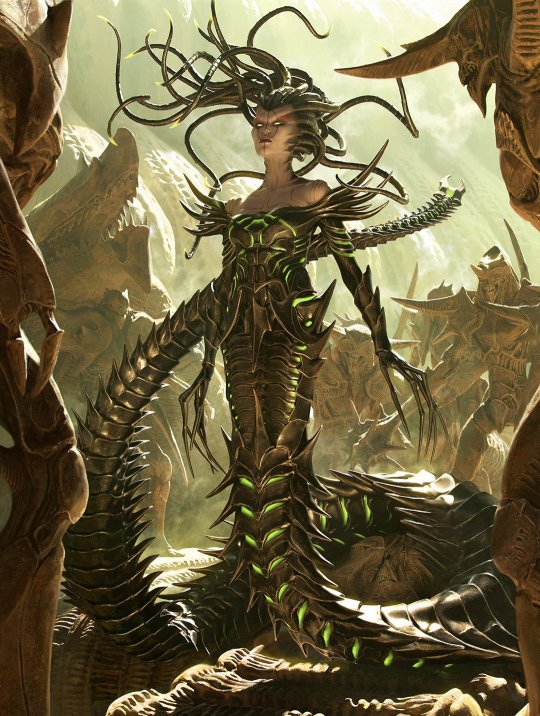
Vraska, Betrayal’s Sting (art by Chase Stone)
I’d even argue that getting to reject humanity as it has rejected you is part of the appeal of compleation. This isn’t quite transhumanism; I might call it exhumanism: the freedom to unearth a way of being that is no longer being human. This is why compleation is coercive, remember? The fantasy allows you to get to this point without making the unimaginable decision to reject not only your individual social obligations, but the idea that you could owe anyone or everyone any kind of social conformity simply for having been born into your species—and then you get to be a cool and powerful cybergorgon.
This, then, is why I don’t blame someone like Sam Gaglio (who is to the best of my knowledge both cisgender and able-bodied) for not really getting what’s going on with Phyrexia. He lives on the before side of the horror of transformation; he’s never had to cross over.
In fact, I’d go one step further here. Phyrexia has existed for almost thirty years, and in that time it’s changed quite a bit. Gaglio quotes an article by Rob Bockman in Hipsters of the Coast which comments on how the shift in the depictions of Phyrexia from 1994 to 2000 reflected shifts in cultural fears over time. The Satanic Panic shaded into multidirectional Y2K anxieties, and the necromancy of original Phyrexia mutated into technological horror. This is what effective horror does: it reflects the fears of its age back to us.
Today, Phyrexia is a seductive, corrupting influence. They have figured out how to compleat planeswalkers—the protagonists of Magic storylines; named, important characters (and Lukka)—which was previously thought impossible. Characters we knew and loved (and Lukka) are seduced, brainwashed, bodily violated, surgically altered, and returned to us unrecognizable. It is not coincidental that this version of Phyrexia is concurrent with the worst wave of anti-transgender legislation to hit the United States in decades—legislation which plays on the specters of the transsexual bathroom predator and on the brainwashed child transitioner, on the idea that transsexuality is a form of social contagion we must protect our children from even learning about. The horror of Phyrexia in its current incarnation is a mirror of our cultural fear of transsexual bodies.

Irreversible Damage: the Transgender Craze Seducing Our Daughters (art by Lauren K. Cannon)
I want to be very clear here—actually, one moment, my extremely funny Abigail Schrier joke notwithstanding, I do need to tell you that the actual name of the above card is “Furnace Punisher”, which is just peak Phyrexia—I want to be clear that I am not ascribing any kind of malice or antipathy towards trans people, either intentional or unconscious, to Wizards of the Coast or the people who make Magic: the Gathering. I would be shocked if anyone there set out to make Innsmouth-style horror about transsexuals. Nor am I upset that they kind of have! Something being fun and interesting is way more important to me than whether or not it’s problematic, and it’s not like I haven’t seen way more vicious horror about transsexuals. We’ll laugh about this someday, in the coral gardens of Y’ha-nthlei, and you’ll wonder what you were ever so afraid of.
In fact, this is another reason why Phyrexia is so appealing to people like us: we are a kind of social contagion. We are carriers for the viral idea that modes of being outside patriarchy and the nuclear family exist; that gender is a marketing demographic, not an ontological truth; that damn near everything about the world we’ve built is not a necessary fact but a social construct contingent upon a half-dozen other social constructs. A new world grows from many, many seeds, and this one germinates in us.
Anyway! What were we talking aboFIVE.

//please state your name for the record
bone-wife / spit-dribbler / understudy for the underdog / uphill rumor / fine-toothed cunt
- Franny Choi, “Turing Test”, from Death by Sex Machine
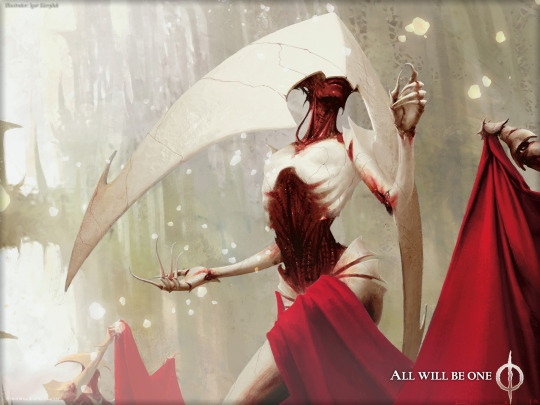
Elesh Norn, Grand Cenobite (art by Igor Kieryluk)
There is a gravitational pull this painting exerts on people. Even people who don’t get Phyrexia find themselves drawn in, find it difficult to look away (e.g. 26:30 in that Rhystic Studies video.) I have for a long time maintained that Elesh Norn is the hottest character in Magic, and that Kieryluk’s portrayal of her is the best art in Magic, and neither of these opinions are particularly surprising coming from me. What is surprising is just how many people also converge on Miss Multiverse’s-Most-Fuckable-Pyramid-Head as, not just a sex icon of Magic: the Gathering, but the sex icon.
Well, or is it? Giant anchor-shaped porcelain mask aside, her silhouette is more or less that of a painfully-thin woman; she stands fully twelve feet tall, and we remember how wild everyone went over Resident Evil: Village’s woman who was only three-quarters of that; and though not an artificial intelligence herself, it’s hard not to place her somewhere in the Cyberqueen lineage. Like SHODAN, like GladOS, like Cyberqueen, she exerts a near-omnipotent level of control over (part of) her world; like them, she is a megalomaniacal egotist (though she cloaks her egotism in piety); like them, she is happy to render you more useful to her via surgery, brainwashing, or deadly neurotoxin. Her mask obscures where her eyes would be, and if I’ve learned anything from a decade of playing or mostly watching other people play the various Dark Souls games, it’s that people go apeshit for character designs without visible eyes (see also: the xenomorph from Alien; I did a whole thing on this subject somewhere back in the Wifelink archive.) So you’ve got a 12′ nigh-omnipotent eyeless dominatrix mostly shaped like a skinny woman, which is maybe pushing a whole lot of buttons at once for a lot of people.
As a character, we don’t know much about her: at some point, she became undisputed leader of the Machine Orthodoxy, the cultiest bit of New Phyrexia. At a later point, she became the extremely-disputed leader of New Phyrexia as a whole. She likes long walks on the beach and multiversal Phyrexian dominion, you get it. There is, however, one good story featuring her, and it is “A Garden of Flesh” by Lora Gray (sorry to give you additional reading in a five-thousand-word essay.) The story is interesting because it is the rare story told from a Phyrexian point of view, and because it flies in the face of many of our assumptions about Phyrexian interiority. Phyrexians, we’re told, lack souls. They’re unfeeling, more machine than man. They most certainly don’t dream.
“A Garden of Flesh” is what happens when Ashiok, planeswalker architect of nightmares and an eyeless smokeshow in their own right, gets curious about whether they can induce nightmares in a Phyrexian mind. What follows is a curiously-effective piece of body & transformation horror, told from the point of view of what is supposed to be the awful endpoint of transformation horror. What does a perfect, powerful biomechanical creature fear? The organic, soft, spongy. Putrefaction. Decay. What does such a creature fear becoming? Human.
I didn’t devote a fifth of this essay to Elesh Norn just because she’s unbelievably hot (although dayenu), but because of this story, and how it complicates our thesis. The horror of transformation is traversible, yes, but what will you find on the other side? More transformation. More horror. And transformation is inevitable: who of us are who we expected to be? Who of us still hold dear the precious things of childhood? And even you few who are raising your hands right now, you too will experience transformation. Should you live long enough, you will find yourself changing. Your body and mind will grow rebellious, unreliable. You will grow old. You will decay.
And yet—it’s a matter of perspective, of where you weight your focus, isn’t it? There will always be more transformation and more horror, but there will always be a way through it. There will always be another shore upon the other side. You will change. You will become unrecognizable to who you were before. You will be fine.
Incompleat Bibliography & Further Reading/Viewing/Playing
Rhystic Studies, “Phyrexia is Hell”, 2023.
H. P. Lovecraft, The Shadow over Innsmouth, 1931.
Shirley Jackson, The Haunting of Hill House, 1959.
Alex Garland, Annihilation, 2018.
Harlan Ellison, “I Have No Mouth, and I Must Scream”, 1967.
Ken Levine, System Shock 2, 1999.
—never played it myself. Mostly I just open up a youtube video of SHODAN voice lines when I want to get belittled by an AI dominatrix.
Valve, Portal 2, 2011.
—there is a lot more to be said about GladOS and Elesh Norn specifically and their respective fraught relationships with the idea of their own humanity.
Porpentine Charity Heartscape, Cyberqueen, 2012.
—whence my chapter header screenshots. Seriously, this game fucks so hard.
Franny Choi, Death by Sex Machine, 2017.
—Choi is making extensive use of cyborg metaphor to address the specific experience of being a Korean-American woman. This is very different from anything I’m talking about, but it also always felt extremely relevant to me as a trans woman. Subaltern-to-subaltern communication.
Lora Gray, “A Garden of Flesh,” 2022.
—it’s no accident that the author of the one good story told from a Phyrexian POV is nonbinary.
hbomberguy, “Outsiders: How To Adapt H.P. Lovecraft In the 21st Century”, 2018.
Jacob Geller, “Who’s Afraid of Modern Art: Vandalism, Video Games, and Fascism”, 2019.
Caitlín R Kiernan, The Drowning Girl: A Memoir, 2012.
—only tangentially relevant, except insofar as it recontextualizes the Lewis Carroll line I open the essay with, and insofar as it is my favorite novel and I’m writing the bibliography. Debatable whether it counts as transformation horror, and I imagine the author would bridle at its being described as horror, but nevertheless: you should read this book.
2K notes
·
View notes
Note
Hi my speical interests is sea creatures/marine life and I would really love some nurse shark facts or beluga whale facts
I'd be glad to help!
Ginglymostoma cirratum or Nurse Sharks are usually found in shallow water and are nocturnal predators. They usually stick to the on the floor of coral reefs and coastal shelves. They usually eat lobsters, small stingrays, sea urchins, fish, and more!
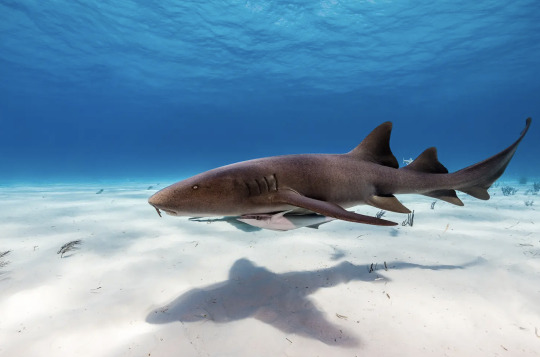
The two little whisker looking things by the mouth are known as barbels- they're sensory organs that the shark use to sense the prey that are usually hiding in the sand. They also have really strong jaws used to crush the clam shells of their prey! They're fairly docile, which leads to people underestimating them. But like all wild animals, they're unpredictable. They've been known to sometimes bite people who interact with them in the wild.
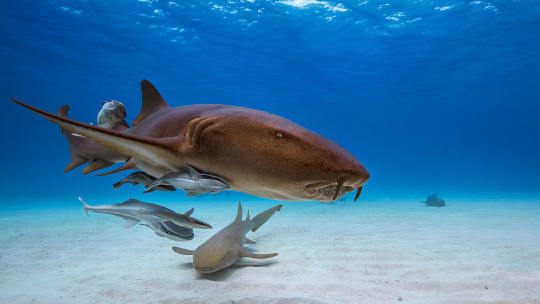
These sharks are ovoviviparous, meaning they give birth to live baby sharks instead of laying eggs. They're born only about 0.3 m (a foot) long, but eventually grow to be around 4.3 m (14 ft) long as adults!
Beluga Whales are my favorite marine mammal! Here's one of my other posts about them!!!
#marine ecosystem#marine creatures#marine life#marine biology#marine animals#sea#sea creatures#sea animals#science#biology#ecology#animals#sharks#nurse shark#nurse sharks#beluga whale#icthyology#nature#wildlife#conservation#marine conservation#earth#ocean#oceans#shark#shark facts#animal facts#fun facts
445 notes
·
View notes
Note
[Occ question] are the sillys based on any villains and if so who? :]
[Ooc answer]
Hey! Yeah, I'll go first (From 🐟 mod, and also the person that does any non-mod tagged asks/posts)
🐟 Waiter is twisted from undertow, the secondary antagonist of 'The Little Mermaid II: Return to the Sea' - Mainly just to follow the little mermaid theme, and due to my enjoyment of the colours used in his design.
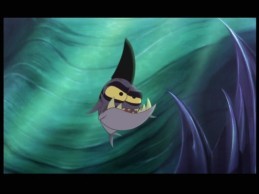



He's supposed to be a third year (he got held back) that goes by the name Ulysses Tide, working at the lounge in hopes of paying off Azul to return him to his true mer-form and get him out of the punishment he was given back in the reef. Along with his transformation into a pihrana mer, the poor guy got substantially shorter, and now stands at.. 5" in his human form. Womp womp
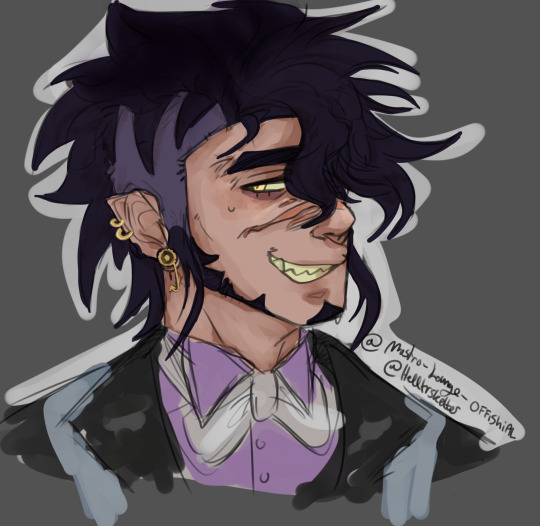
Here's a super quick little doodle of the guy, (if you recognise my art from another blog I run no you don't). The mods here at the mostro lounge offishial blog thank you greatly for your queries and curiosity <3.
AND HI I'M THE GUY BEHINF THE LOBSTER hi hii I'm mod 🦞🦞🦞🦞🦞 hi so I cannot explain my bullshittery but. Evil Sebastian the Crab but he's a lobster instead. Okay so. H.ear me out he's one of the funky split lobsters.



His name is Sylo Mariathic and he hates everything but is also so so cool (he is a loser nerd). He is bisexual and a Second year (Age 17). He hates his job but he works it for one simple reason. Money. Ohhhh boy does he love money. Stands at a whopping 5'9!


I made a sprite thingy of him + my one doodle of his design when I first made it ♡
#twst#twisted wonderland oc#twisted wonderland#twst oc#twst octavinelle#octavinelle#[waiter: 🦞]#[waiter:🐟]#twistedwonderland#mostroloungeoffishal#mostro lounge#mostro lounge twisted wonderland#twisted wonderland mostro lounge#twisted wonderland rp#mod art lol
67 notes
·
View notes
Text
Dark Blue Moon and the Suffering Sun Chapter 19
MASTAPOST
Danny woke from his little cat nap soon after, stretching his tail out like a lounging snake. Damian sat next to him, characteristically unimpressed as the teenager cracked his knuckles and shook off the remaining grogginess.
“Are you done?” Damian asked.
Danny yawned again. “Yeah what time is it?”
“It has been about two hours. We are wasting time.”
Damian swam to Danny’s left side and nudged him with his head. Danny bonelessly flopped to the side without moving. “Dude, what’s the rush? I thought you liked animals.”
“The whales have been amenable company, but my father needs me back as soon as possible. In addition, we have entered a coral reef.”
Danny blinked, and got up. The boy leaned his head over the edge of the mother whale. Seemed Damian was right. The waterscape in front of them was filled with tall kelp forests in the distance. Below the, the sea floor housed miles of vibrant coral in all sorts of colours. Red, purple, yellow and green coral spiraled and twisted and grew from the rocks and sand, living alongside schools of big and small fish. Clownfish peeked in an out of anemones. Little critters like shrimps and lobsters crawled in and out of crevices, sheltered from predators.
Damian apparently thought he was taking too long. Danny belatedly realised his harness was untied, just as Damian rammed into his back and pushed him off the edge.
“We need to replenish our supplies.” Damian said. “Teach me how to gather forage and hunt.”
Well that was a slight issue. Being a modern American teenager with access to such things as fridges and a global supply chain meant that he was perhaps less suited to roughing it than the younger boy might have assumed. It was not like he never had to live off the land, but the less said about long swim home after Vlad happened, the better.
“Well?” Damian repeated, arms crossed, looking down Danny expectantly.
“Alright then. I’ll teach you silly human what it’s like to live off the land, like your ancestors long before you.” He said sagely.
The whale pod crooned a deep farewell as the continued on their journey. He and Damian waved them off, before returning to their own needs.
He led his young charge to perch atop a cliff overlooking the reef. The boys laid their fins flat so as to avoid drawing attention. Danny scanned the landscape, settling his eyes on a lobster hiding underneath a rock. Despite their reputation these days, lobsters did not look nearly as appetising raw and alive. From the bottom, they looked more like cockroaches than delicacies. Plus, they were literally the worst possible travelling food ever. No.
Instead, Danny caught sight of his real prize. Mussels!
“You good with shellfish?” He asked the younger boy. Damian turned up his nose, looking haughty like Sam’s parents were it not for the adorable pout he’d put on too.
“If the only other option is starvation.”
“We’ll keep an eye for more plants on the way.” Danny said, preparing to descend.
The thing about mussels was that you didn’t need to kill them to bring them along. They came with their own natural packaging, even if it was a bit heavy. Danny stuffed his pockets with a couple handfuls of the shellfish, leaving space for a more varied diet, and leaving the rest to stay and reproduce. He wasn’t greedy! Sam had taught him about these things. Mussels were very important to the environment. Evidently Damian was aware too. The boy nodded in approval as Danny continued his search.
Damian’s sword came in useful as well (he would’ve taken it away if he wasn’t sure that the kid would slash him for it) for harvesting kelp and seaweed. The pair snacked on kelp strips as Danny took them to their next prey.
However, Damian protested. “I do not wish to kill this one.”
The huge trout, easily as big as Damian, floated blissfully ignorant of the two predators eyeing it like hawks. Danny ‘s head spun as he tried to keep track of Damian’s seemingly endlessly shifting opinion towards eating fish or not. “That thing could feed us for like 300 miles.”
“The largest fish also reproduce the most. This one is a female.” Damian continued. Now that he thought of it, didn’t Sam make a whole protest about this in the beginning of summer? “Many oceans are in danger due to overfishing from humans. As a human myself, it is my responsibility to fish sustainably.”
The boy’s fins puffed with pride and conservationist fervor, a quiet determination that reminded him of Sam. Danny had some doubts. “If we eat the small fry, there won’t be many left to grow big and ‘reproduce’ as you say.”
This point seemed to put pause on Damian’s previous showboating. The boy gritted his teeth, looking for a comeback. “What about invasive species? Those that threaten the natural balance.”
Danny shrugged. That was a good point, except Danny didn’t know how to identify any of those.
“But you live in the ocean!” Damian protested when this point was brought up.
“Yeah. You live on land. Does that mean you know about every species that lives on Gotham?”
“Yes.” Well he kinda walked into that one, didn’t he?
“Well if you know so much about invasive species, why don’t you look for them?” Danny challenged. Animal hyperfixation or not, surely this kid couldn’t identify the hundreds of species that lived in this reef.
Damian’s ear fins tensed, something he’d noticed in himself whenever he was concentrating on something. The boy turned away from Danny and to the reef in front of them. Suddenly, the boy’s body slumped.
A smug grin split open Danny’s face.
Damian groaned, as if his next words were like Soviet torture. “There are no saltwater invasive fish near California, to my knowledge.”
“Hah! Suck on that, fishboy!”
Damian mewled angrily. His hand drifted down to the hilt of his sword. On dear.
“Alright, alright, alright. What about a compromise?” Danny waved his arms defensively.
“Speak.”
“We grab the fish that we were gonna grab before you interrupted.” Damian hissed at that. “BUUttt only one. And we fill our pockets with small fry. A balanced fishing diet. What do you say?”
The grumpy child pouted one more time for good measure, before sinking back to the floor. “Fine. You still need to teach me how to make a kill.”
“You sure you won’t get attached?”
“I can suppress my emotions to complete the mission.” It spoke something about Damian that Danny wasn’t even that phased this time. That being said please let that just be a boast with nothing to back that up.
Danny lay prone, fins flat, head down, like a tiger about to pounce. In the entire conversation they’d had, the trout had drifted about five inches from its previous position. Survival instincts this poor girl had not.
“All you need to do is shut your gills, like holding a breath. Just get closer… and closer… and POUNCE!”
Danny leapt at the trout, using his powers to accelerate into a blur. His hands pinned it down in an instant, the trout thrashing and slapping him, trying to escape. With a swift motion, Danny bit clean through its gills. The trout rapidly lost strength, slowly fading until it went still.
He held the trout up like a trophy. “Tada!”
Damian frowned deeply. “That was an unclean kill. It suffered immensely.”
“Ughh!” Danny groaned. “What do you want from me. I’m a siren not an assassin.”
Damian unsheathed his sword, looking about 50% more menacing as any other six-year-old Danny had ever met. “It seems I will have to show you, instead.”
Five minutes later, his idea of showing Danny how to kill resulted in a fresh bruise and a bent fin. The carp he had tried to pounce managed to escape with a shallow cut on its side.
“I’m very educated now, Damian. Thank you.” He snickered as Damian roared in anger.
“Shut your mouth! You have an unfair advantage, seeing as you can use your powers, while I am hampered by my body.”
“You’ll grow into them. I think. I dunno I haven’t met a lot of siren kids.”
“I am not a child!” Damian said, pouting very maturely.
The rest of the morning was spent like that, roaming the reef in search of food and bickering over this and that. At one point they debated over dolphins were whales or not (Danny personally thought whales were too nice to encompass dolphins under their umbrella).
Their food supplies replenished and energy still raring to go, the boys sealed their satchels shut, and continued south.
Meanwihle…
Hundreds of miles away in the ocean, Bruce stands at the helm of the Fenton Family SAV, its modified engines going at full throttle.
In a hidden compartment in his room, Tucker Foley slams into the firewall of the Fenton’s new database with everything he has. Schematics, blueprints, notes. He needs that data and he needs it now.
Sam Manson meditates on her bed, surrounded by candles. She recites warding spells, a staple for any young magician.
Skulker sits in his private yacht, bandaging his wounded leg, sliding the pieces for his next upgrade. Behind him, an ornate fish tank sits empty, awaiting its guest.
Agent K and Agent O monitor the news. The sonars around Amity. A report sits on the desk. The Fentons have just left town? That will be interesting…
#dpxdc#danny fenton#damian wayne#dcxdp#merman#merboy#angst#mermaid au#fluff#hunting#hunting of animals#mer!danny#mer!damian wayne
48 notes
·
View notes
Text
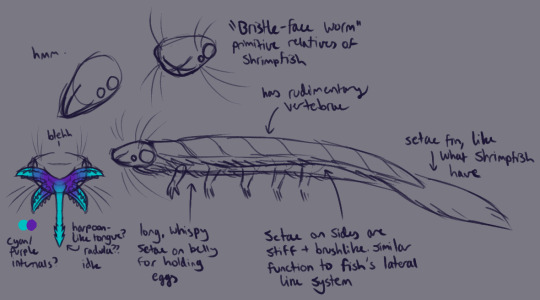


revisiting dragon shrimpfish and their relatives!!
"Bristle-face worms" (better name pending) are a sister clade to the shrimpfish. They retain more primitive traits, such as having more limbs, less developed vertebrae, etc.
My current thinking is that bristle-face worms are usually benthic or live in burrows. The benthic species roam the ocean floor in search of dead animals while the burrow-dwelling species are ambush hunters. Most of the bristle-face worm species are long extinct. Also, these guys will travel long distances to search for mates. Their luxurious "bristles" (antennae) help them detect pheromones released by potential mates.
Meanwhile, shrimpfish (or at least the early ones) are reef-dwellers. There are some species that are very similar to early shrimpfish and they're basically cleaner shrimp. Also they are quite small (dragon shrimpfish themselves are 4 inches long?).
Both clades have weird mouthparts that are comprised of 4 jaws (which open like the petals of a flower) and a tongue. I'll have to figure out what exactly the tongue is for. I'm leaning towards the tongue being used to pull food into the throat (similar to the pharyngeal jaws that moray eels have). Some species do use their tongue as a harpoons though in a similar way to cone snails.
Both clades also have a line of setae on each side of their body. These setae have a similar function to the lateral line system of fishes, allowing the animal to sense water currents around them. These setae are stiff and brushlike.
The belly setae, on the other hand, are softer and longer; good for sticking eggs onto. Both shrimpfish and bristle-face worms carry their eggs for a while before dropping them somewhere suitable, not unlike what lobsters do.
Primitive species like these don't have much in terms of magic use. They are able to sense the presence of environmental magic but that's about it
Notes transcript and all that under the cut
1st Image
"Bristle-face worms" primitive relatives of shrimpfish
cyan/purple internals?
harpoon-like tongue? radula?? idk
has rudimentary vertebrae
long, whispy setae on belly for holding eggs
setae on sides are stiff and brushlike. similar function to a fish's lateral line system
setae fin, like what shrimpfish have
2nd Image
part of the jaws are inside the head when at rest. they move forward, then outward
some species have jaws that snap shut like a bobbit worm's
bristle-face worms and shrimpfish have similar faces?
3rd image
shrimpfish vs bristle-face worms
shrimpfish:
tail is flattened
reduced tail plates
tail for propulsion, limbs for swimming
bristle-face worms:
whole body is flattened vertically
2 pairs of feeding arms
shrimpfish lost the 4th and 5th limb pairs
poor swimmer, mostly crawls
#raintailed's art#raintailed rambles#skylight#worldbuilding#speculative biology#long post#i love these silly guys. i love figuring out what traits are primitive and what aren't
57 notes
·
View notes
Text
Animal of the Day!
American Lobster (Homarus americanus)
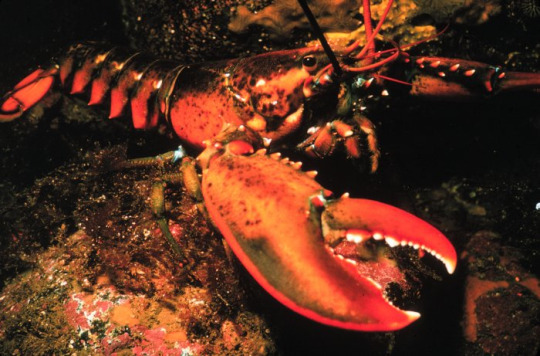
(Photo in Public Domain)
Conservation Status- Least Concern
Habitat- Northwest Atlantic Ocean
Size (Weight/Length)- 60 cm
Diet- Sea urchins; Mollusks; Marine worms; Starfish; Crabs
Cool Facts- While you’re more likely to have an American lobster end up on your plate, not many people know how important they are in their ecosystems. They eat huge amounts of over populated sea urchins that destroy mass areas of kelp reefs. These reefs provide homes for hundreds of species of the fish and the American lobster acts as a guardian alongside sea otters and sheepshead. These lobsters can live up to 100 years old and can weigh more than a human baby. There are strict regulations on the harvesting of American lobsters, mostly regarding the protection of egg carrying females and the massive breeder males.
Rating- 12/10 (Keeping the ocean healthy, one snack at a time.)
#Animal of the day#Animals#Crustacean#Friday#May 19#American lobster#Lobster#biology#science#conservation#the more you know
147 notes
·
View notes
